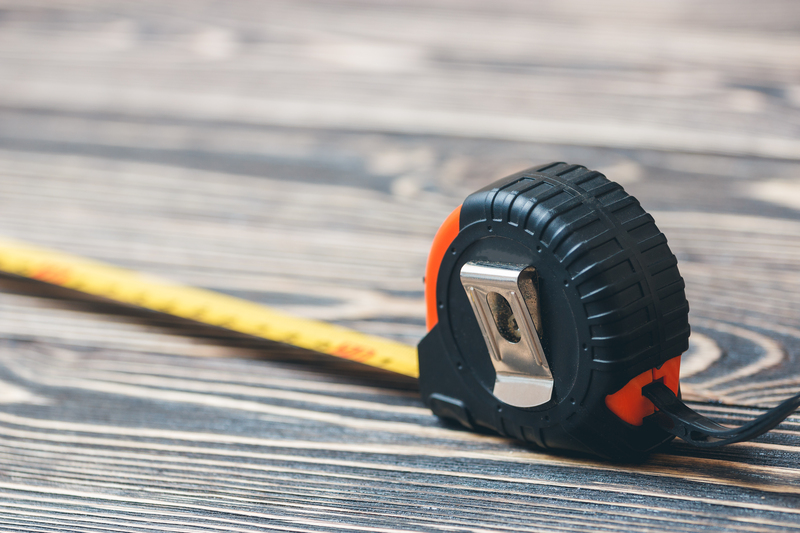Protect Your Sofa: Long-Term Care Tips from the Pros
Posted on 17/05/2025
Protect Your Sofa: Long-Term Care Tips from the Pros
Sofas are more than just pieces of furniture--they are the heart of our living rooms, the place where memories are made, and often significant investments we want to keep looking their best. Protecting your sofa for the long run is an essential part of caring for your home. In this comprehensive guide, you'll discover professional sofa care tips that not only extend your sofa's lifespan, but also keep it looking comfortable, clean, and welcoming for years to come.
Why Long-Term Sofa Care Is Essential
Your sofa often serves as the focal point of your living space, facing regular use and sometimes even abuse. Prolonging the life of your sofa is not just about maintaining its appearance; it also preserves comfort and function while saving you from frequent replacements. Let's explore the multiple benefits of sofa protection and care:
- Cost-Efficiency: With proper couch maintenance, you delay the need for costly repairs or replacement.
- Cleanliness: Routine cleaning reduces allergens and keeps your family healthier.
- Aesthetics: A well-cared-for sofa enhances your home's decor and adds value to your space.
- Durability: Quality care translates to long-lasting materials and supportive structure.
Professional sofa care techniques are designed to ensure every type of fabric or leather remains beautiful. Read on for detailed, actionable steps you can take to keep your couch in peak condition.

Expert Sofa Protection Strategies
1. Understand Your Sofa Material
The first step to protecting your sofa is to identify the material. Sofas come in many materials--leather, synthetic fibers, linen, cotton, velvet, microfiber, and more. Each requires a unique approach for long-term care:
- Leather: Needs special cleaners and conditioners--avoid harsh chemicals.
- Fabric: Check manufacturer labels for cleaning codes like "W," "S," or "WS" to guide your cleaning methods.
- Microfiber: Generally stain-resistant but can be damaged by excess moisture or inappropriate cleaners.
2. Vacuum and Dust Regularly
Accumulated dust, crumbs, and debris don't just look unsightly--they can wear down fabric and attract pests. Vacuum your sofa at least once a week with a soft brush attachment, paying special attention to crevices and seams. For leather sofas, use a soft, dry cloth or a vacuum with a gentle brush to remove dust before treating the leather with conditioner.
- Tip: Use compressed air to clear out those hard-to-reach spots.
- Tip: Keep pet areas clean to prevent fur build-up and odors.
3. Rotate and Fluff Cushions
Sitting in the same spot every day can cause uneven wear and sagging. Prolong sofa life by rotating and flipping cushions regularly. Fluff cushions to maintain their shape--a quick shake often does the trick for both fabric and feather-filled cushions. If your sofa permits, swap seat cushions and back pillows for even wear across all areas.
4. Use Slipcovers and Throws
Want a simple solution for sofa protection? Slipcovers, throws, and armrest covers add a stylish layer while shielding the upholstery underneath from spills, pet hair, and daily wear. Choose machine-washable slipcovers for hassle-free cleaning. Throws are especially effective on households with children or pets, letting you refresh the look and cleanliness of your sofa with minimal effort.
5. Avoid Direct Sunlight and Heat
Exposure to sunlight can cause sofa material to fade or become brittle over time. Arrange your sofa away from windows or use curtains and blinds to block direct sunlight. Similarly, keep your sofa clear of heat sources like radiators, fireplaces, or heating vents to prevent fabric deterioration and leather cracking.
- Tip: Use UV-blocking window film for added protection if your living room is bright and sunny.
Cleaning Techniques for Long-Lasting Sofas
1. Immediate Attention to Spills and Stains
The most effective sofa protection tip is to address spills as soon as they occur. Blot up liquids with a clean, absorbent cloth--never rub, as that will spread the stain further into the fabric. For solid residues, gently lift away with a dull knife or spoon before blotting. Always consult your sofa manufacturer's cleaning recommendations before applying cleaning solutions.
2. Use the Right Cleaning Products
Different materials require specific care. Always read product labels to check if a cleaner is suitable for your sofa type. Here's a quick guide:
- Leather: Use pH-neutral or leather-specific solutions. Avoid products containing alcohol or ammonia.
- Microfiber: Water-based solutions work for most, but check for any solvent-based cleaning codes.
- Fabric: Spot clean with mild dish soap and water, or fabric-safe upholstery cleaners as per label instructions.
Test any cleaner on an inconspicuous spot first to avoid damage or discoloration.
3. Deep Clean Every 6 to 12 Months
For comprehensive sofa care, professional cleaning is highly recommended. Deep cleaning eliminates deep-seated dirt, bacteria, and allergens that regular vacuuming might miss. Homeowners can also use rented upholstery cleaning machines or steam cleaners (provided your sofa material is compatible). Always allow your sofa to dry thoroughly afterward to prevent mold and mildew growth.
Preventing Damage: Dos and Don'ts of Sofa Use
Dos
- Use coasters and trays when eating or drinking on the sofa to prevent accidental spills.
- Keep sharp objects and pets' claws away to avoid tears or scratches.
- Teach children to treat the sofa gently--no jumping or standing.
- Encourage regular cleaning and care as a family habit.
Don'ts
- Don't expose your sofa to moisture for prolonged periods.
- Don't use harsh or abrasive cleaners that can degrade materials.
- Don't ignore minor damage--attend to small tears, stains, or loose threads promptly to prevent worsening.
- Don't drag the sofa across the floor--always lift to protect both furniture and flooring.
Fabric vs. Leather: Unique Care Considerations
Fabric Sofas
Fabric sofas require routine upholstery protection to stay fresh and vibrant. Use fabric protectant sprays recommended by furniture stores or manufacturers for your specific fabric type--these products help repel stains and keep colors looking new. Schedule spot checks for signs of pilling, and use a fabric shaver if necessary.
Leather Sofas
Leather needs special attention for ultimate longevity. Condition at least twice a year with a good quality leather conditioner to maintain suppleness and prevent cracking. Wipe spills immediately, and avoid using baby wipes or any cleaner not designed specifically for leather. Over time, leather develops a unique patina--gentle, regular care will enhance this natural beauty.
How to Protect Your Sofa from Pets and Kids
For Pet Owners
- Trim pet nails regularly to reduce accidental scratches.
- Train pets to use designated beds or mats instead of the furniture.
- Lay washable pet throws or covers over favorite napping spots.
- Quickly clean any pet stains with enzyme-based cleaners to neutralize odors.
For Families with Kids
- Choose family-friendly fabrics designed to resist stains and wear.
- Keep food and drink rules for the sofa--water only, or snacks at the table.
- Put removable, washable slipcovers on your sofa for ultimate peace of mind.
Investing in sofa protection products such as waterproof liners or spray-on fabric guards goes a long way in busy households.
When to Call the Pros: Expert Maintenance and Repair
No matter how meticulous you are, regular professional assessment is invaluable. Professional upholstery cleaners have the expertise, equipment, and products to address tough stains and deep-set dirt, and they can often repair small damage before it becomes a big problem. If you notice:
- Persistent odors despite cleaning
- Deep, stubborn stains
- Loose frames or broken springs
- Significant sagging or loss of cushion support
It's time to call in the experts. Annual or biennial professional cleaning can refresh even the most well-loved sofas.
Extra Tips for Specialty Sofas
- Velvet sofas: Gently brush the nap in the direction of the pile with a soft brush; avoid harsh cleaners.
- Antique sofas: Consult antique furniture specialists for guidance--avoid DIY cleaning.
- Sectional sofas: Clean and rotate sections individually; secure connections to prevent shifting.

Maximize Your Sofa's Lifespan: Essential Takeaways
Summary of Key Points
- Vacuum and dust your sofa weekly.
- Rotate and fluff cushions every few weeks.
- Use covers or throws for easy cleaning and extra protection.
- Keep your sofa out of direct sunlight and away from heat sources.
- Clean up spills immediately, and use the right products for your material.
- Schedule annual professional cleanings for long-lasting results.
- Take proactive steps if you have pets or kids to minimize damage.
The secret to lasting sofa protection lies in consistent, attentive care. By implementing these long-term sofa care tips from the pros, you'll enjoy a sofa that remains comfortable, clean, and inviting for years--delighting your family and impressing your guests.
Conclusion
Whether you have a luxurious leather sectional or a cozy fabric loveseat, sofa protection and care are vital for maintaining the heart of your living space. Small habits such as daily tidying, immediate stain treatment, and regular deep cleaning collectively contribute to a sofa that stands the test of time. Invest a little effort now, applying these pro secrets to sofa longevity, and ensure your beloved couch remains a beautiful, functional part of your home for many years to come.
Want more expert furniture protection advice? Explore our other home care guides, share this article with your friends, and enjoy a happier, healthier home environment--starting with your sofa!



